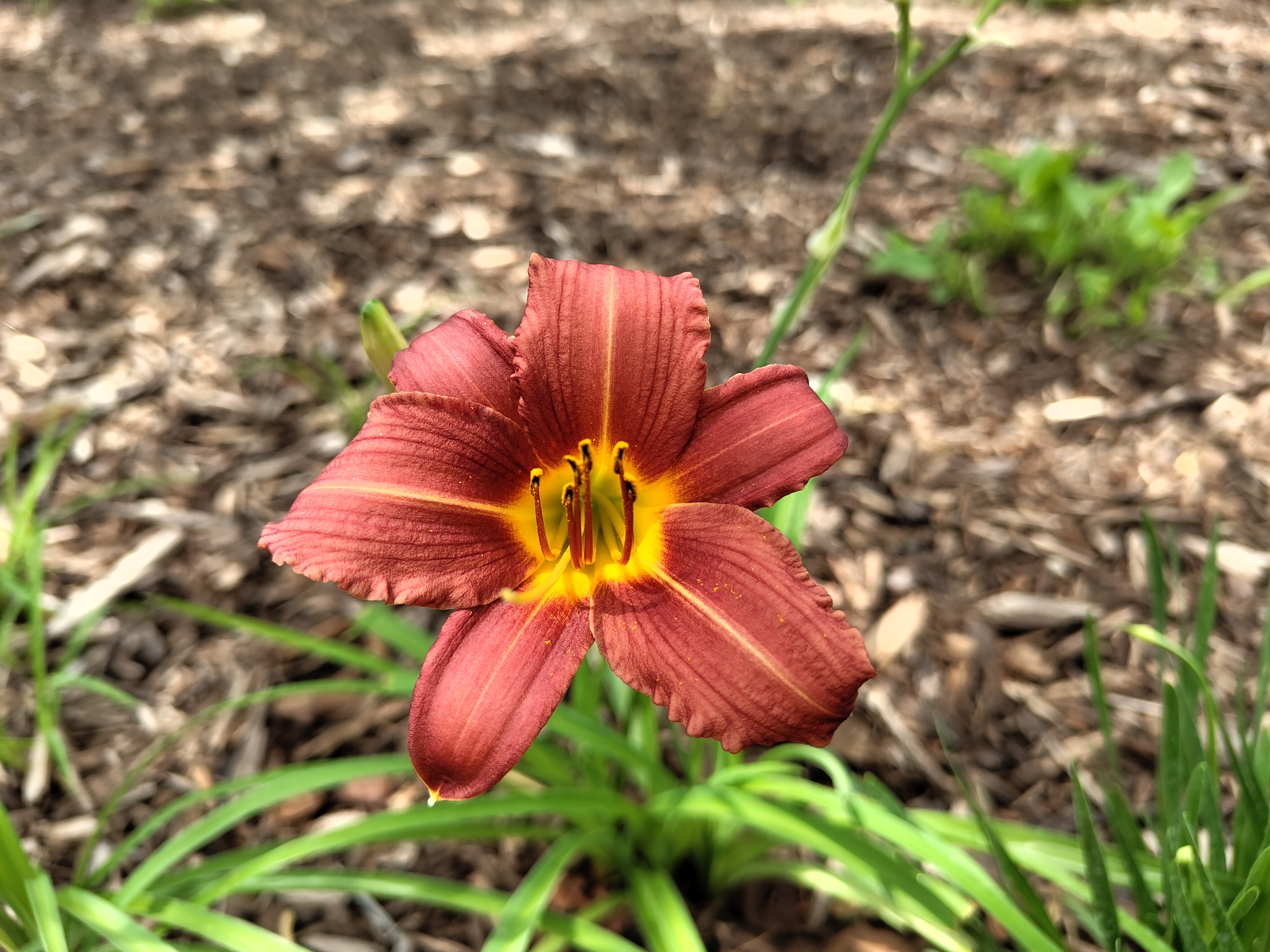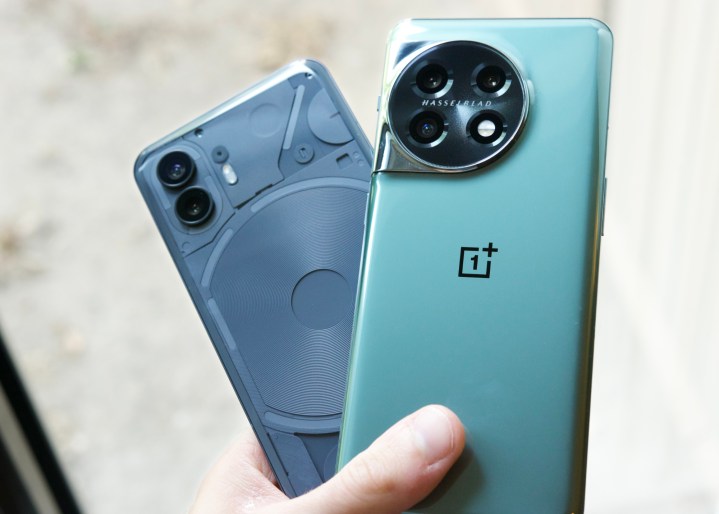
There are currently a lot of solid Android phones to pick up if you’re trying to stay away from some of the bigger names in the space, like Samsung and Google. Both Nothing and OnePlus have launched cutting-edge Android smartphones this year that are some of the best on the market, but making a purchasing decision between the two can be a little tricky.
- Nothing Phone 2 vs. OnePlus 11: specs
- Nothing Phone 2 vs. OnePlus 11: design, display, and durability
- Nothing Phone 2 vs. OnePlus 11: performance, battery life, and charging
- Nothing Phone 2 vs. OnePlus 11: cameras
- Nothing Phone 2 vs. OnePlus 11: software and updates
- Nothing Phone 2 vs. OnePlus 11: special features
- Nothing Phone 2 vs. OnePlus 11: price and availability
- Overall winner: OnePlus 11
Luckily, we’re here to help you compare and contrast both phones and better understand which one is right for you. Regardless of what you pick, you’ll be walking away with a great device. However, there are some major things that set the Nothing Phone 2 and the OnePlus 11 apart.
Nothing Phone 2 vs. OnePlus 11: specs
| Nothing Phone 2 | OnePlus 11 | |
| Size | 162.1 x 76.4 x 8.6 mm (6.38 x 3 x 0.33 inches) | 163.1 x 74.1 x 8.5 mm (6.42 x 2.92 x 0.33 inches) |
| Weight | 201.2 grams (7.09 ounces) | 205 grams (7.23 ounces) |
| Screen size | 6.7-inch OLED | 6.7-inch AMOLED |
| Screen resolution | 2412 x 1080 pixels (394 pixels per inch), 120Hz refresh rate | 1440 x 3216 pixels (525 pixels per inch), 120Hz refresh rate |
| Operating system | Nothing OS 2.0 (based on Android 13) | OxygenOS 13 (based on Android 13) |
| Storage | 128GB, 256GB, 512GB | 128GB, 256GB, 512GB |
| MicroSD card slot | No | No |
| Processor | Qualcomm Snapdragon 8+ Gen 1 | Qualcomm Snapdragon 8 Gen 2 |
| RAM | 8GB, 12GB | 8GB, 12GB, 16GB |
| Camera | 50MP main camera, 50MP ultrawide camera, 32MP selfie camera | 50MP main camera, 32MP telephoto camera, 48MP ultrawide camera, 16MP selfie camera |
| Video | Up to 4K at 60 frames per second (fps) | Up to 8K at 24 frames per second (fps), 4K at 60 fps |
| Bluetooth version | Bluetooth 5.3 | Bluetooth 5.3 |
| Ports | USB-C | USB-C |
| Fingerprint sensor | Yes, in-display | Yes, in-display |
| Water resistance | IP54 | IP64 |
| Battery | 4,700mAh
45W wired charging 15W wireless charging 5W reverse charging |
5,000mAh
80W wired charging |
| App marketplace | Google Play Store | Google Play Store |
| Network support | AT&T, T-Mobile | Most major carriers |
| Colors |
Dark gray, white |
Titan Black, Eternal Green |
| Price | Starting at $599 | Starting at $699 |
| Buy from | Nothing | OnePlus, other electronics retailers |
| Review | Nothing Phone 2 review | OnePlus 11 review |
Nothing Phone 2 vs. OnePlus 11: design, display, and durability
The Nothing Phone 2 and the
Obviously, design taste will vary from person to person. However, the Nothing Phone 2 was designed to be a stylish luxury device, a detail that’s clear when simply looking at the phone’s LED panels and clear-backed design. The
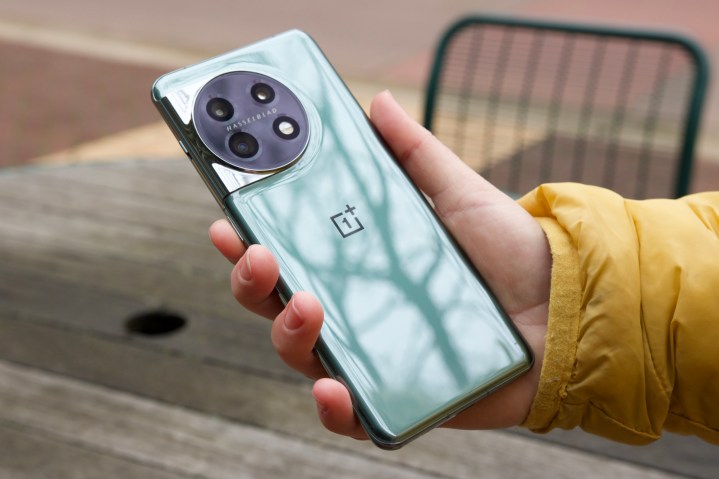
The displays for both phones are sized identically at 6.7 inches with refresh rates of 120hz, offering a smooth user experience. However, their resolutions and PPIs differ slightly. The Nothing Phone 2 has a resolution of 2412 x 1080 and 394ppi (pixels per inch), while the

When it comes to their durability, neither phone is exactly up to the standards set by other major flagships with their IP ratings. The Nothing Phone 2 is rated IP54, which means it’s dust-protected and splash resistant, but isn’t dust-tight or fully waterproof, meaning that it should avoid water at all costs and shouldn’t be exposed to small solid particles like dusty or sandy environments. The
Choosing a winner for this category comes down to preference. The
Winner:
Nothing Phone 2 vs. OnePlus 11: performance, battery life, and charging
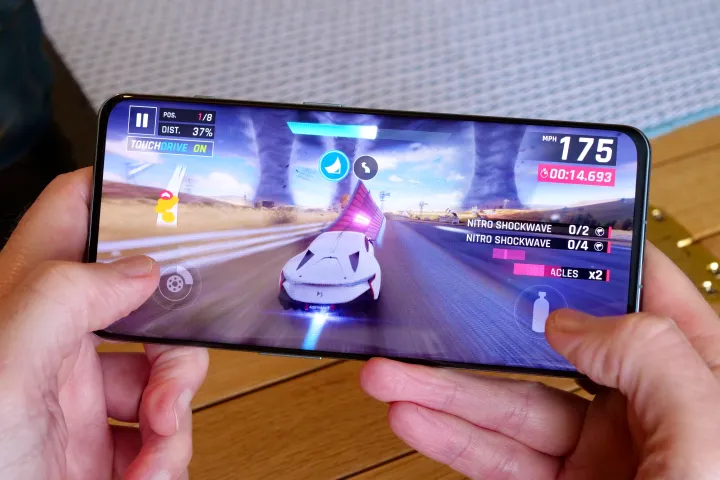
Both the Nothing Phone 2 and the
That said, the Snapdragon 8+ Gen 1 could hardly be described as slow, so if you end up picking up the device, you would only begin noticing an issue if you directly compared it to something with a more recent competitor. Because both phones have displays with 120Hz refresh rates, they both feel snappy and responsive when being used, especially when paired with their chipsets.
The battery in the

What about charging? The Nothing Phone 2 offers 45W wired charging, 15W wireless charging, and 5W reverse charging. Those charging specs are pretty standard for what’s being seen in the current crop of flagship Android phones, and the fact that it supports wireless charging and reverse charging is a huge plus. The
The lack of wireless charging is certainly a knock against the
Winner:
Nothing Phone 2 vs. OnePlus 11: cameras
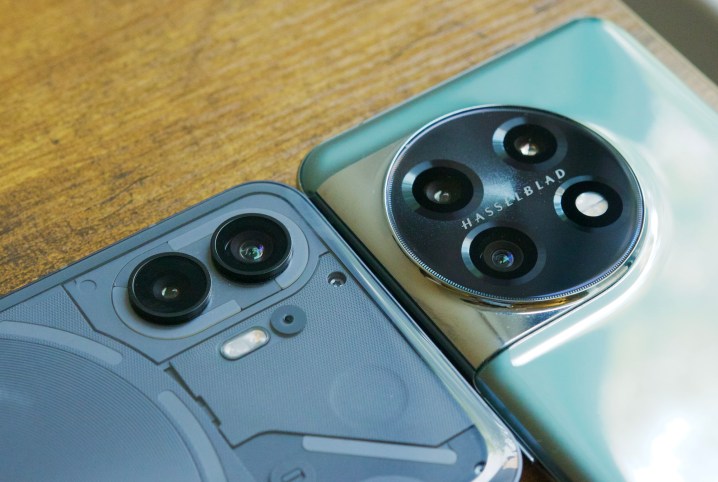
The
The Nothing Phone 2’s 50MP main and 50 MP ultrawide lenses do take excellent photos, especially for the price, offering great colors and consistency across both lenses — something that the Nothing Phone 1 struggled with. The cameras are at their worst in low-light environments, which is a shame, but it’s something that a lot of phones tend to struggle with.
Conversely, the
One might be able to argue that, given the fact that it has an additional camera on its rear, the
In terms of video quality, the
With its telephoto camera and higher-resolution video recording, the
Winner:
Nothing Phone 2 vs. OnePlus 11: software and updates
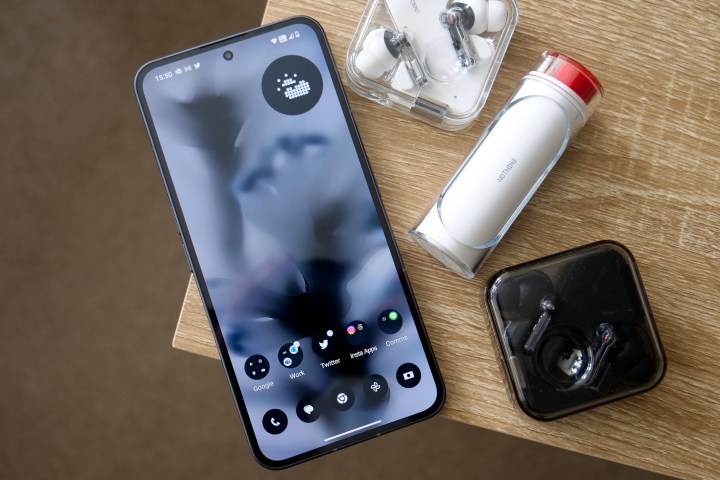
Both the Nothing Phone 2 and the
When it comes to software updates, OnePlus has guaranteed that the
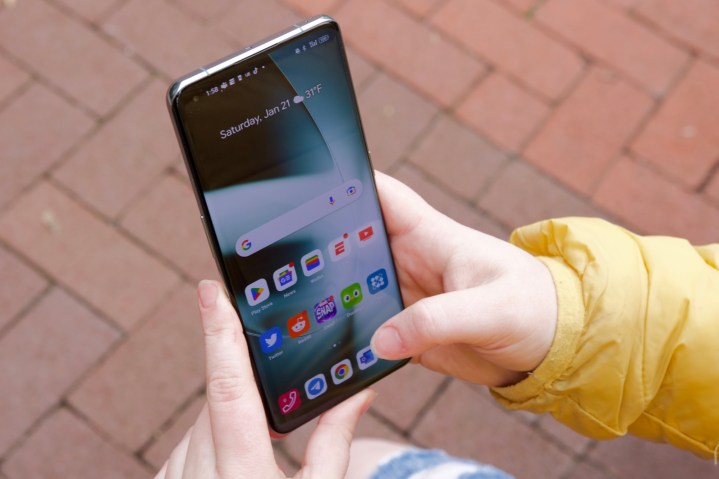
Deciding which phone wins this category is something of a tossup and mostly comes down to preference in the operating system.
If you’re looking for a more robust
Winner: Tie
Nothing Phone 2 vs. OnePlus 11: special features

We’ve already mentioned the lights on the Nothing Phone 2’s backside, but they’re more than just fancy set dressing. In fact, there’s a surprising amount you can do with them.
Their main function is that they’ll light up and flash for notifications you receive — including phone calls, texts, and more. Nothing designed a load of custom ringtones and notification sounds for you to use, each with its own unique sound and light pattern. You can also use the lights as a timer, to see the current volume of the phone, check your charging progress, and more. Some people may find it all a bit gimmicky, but we have to give Nothing credit as they make the Nothing Phone 2 wholly unique from any other

Comparatively, the
Winner: Nothing Phone 2
Nothing Phone 2 vs. OnePlus 11: price and availability
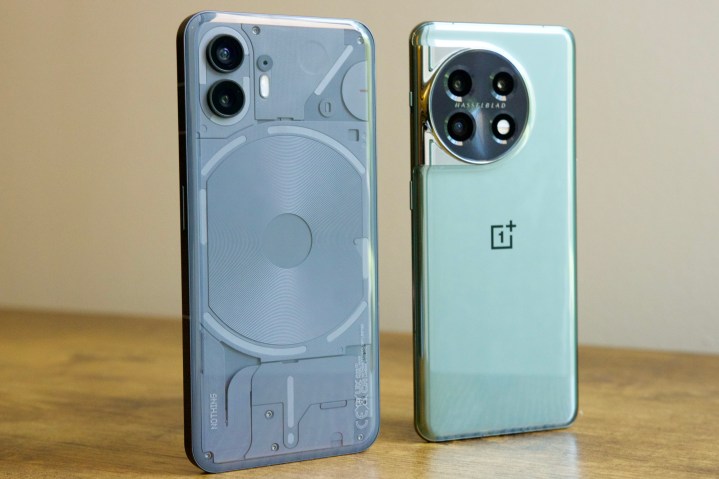
The Nothing Phone 2 is available for purchase exclusively from the Nothing website. There are three different storage and memory options available: $599 with 128GB internal storage and 8GB RAM, $699 with 256GB internal storage and 12GB
The
Overall winner: OnePlus 11
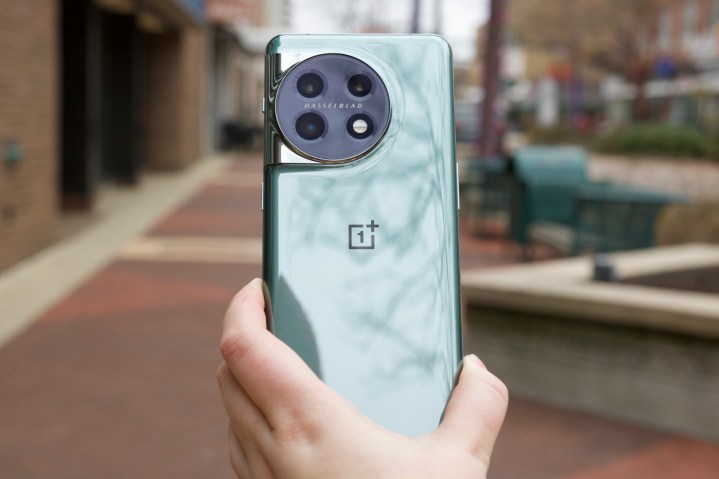
Although the Nothing Phone 2 packs a lot of value, the
As mentioned above, the Nothing Phone 2 was designed to be interesting to look at with its clear back and LED accents, so if that’s something that appeals to you, you won’t find it with the
Some things aren’t about preference, however, and come down to the pound-for-pound differences between the devices. For example, the
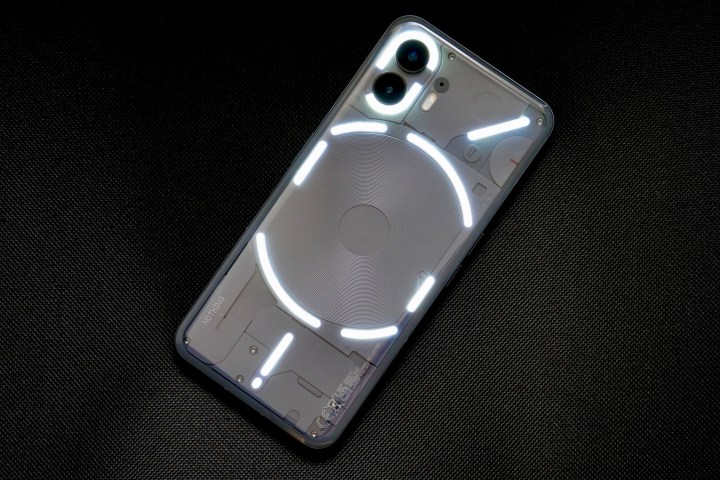
Purchasing a phone is also a pretty large investment for most, so knowing that it’ll be supported with updates for several years is important. In that regard, the
So, what’s the conclusion? If you can afford the extra $100 to get the
These are two of the best Android smartphones released in 2023, and you really can’t go wrong either way.
Editors' Recommendations
- The best Android tablets in 2024: the 11 best ones you can buy
- The OnePlus 12R is still one of 2024’s best smartphone deals
- Every Android tablet we’re expecting in 2024
- OnePlus’ next foldable phone may get a huge camera upgrade
- The OnePlus 12 is the OnePlus phone I’ve been waiting for






